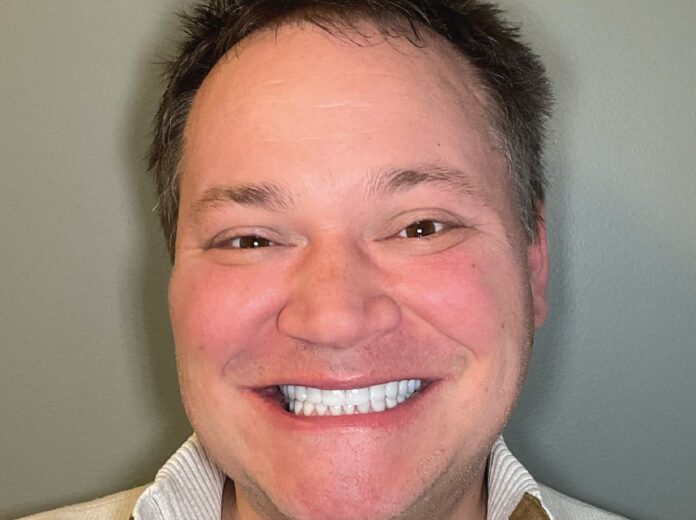
A few years ago, a patient walked into the practice who clearly needed my help. The patient was in his 40s. He had worked at Starbucks for about 20 years as a barista, so he interacted with the public all day. When he came into the office I noticed that he had fractured veneers on his two front teeth. He told me he had gotten the veneers several years ago and had to replace them every couple of years because they kept breaking and chipping off. He said that in the past, he didn’t have the finances for a more permanent solution.
He had gotten the veneers several years ago and had to replace them every couple of years because they kept breaking and chipping off.
Not surprisingly, it wasn’t just the front teeth that were a problem. He had severe bruxism, which contributed to much of his dentition breaking down. He also had a collapsed bite, and the patient’s facial structure was brachiocephalic.

Having a less-than-ideal smile affected his everyday life. He was an outgoing person, but because of his broken teeth, he became very self-conscious and would not smile. He finally decided he was tired of feeling embarrassed about his smile. He said, “I’m sick and tired of looking and feeling like this. I want the best treatment for me.”
When I met the patient, I had just completed three continuing education (CE) courses with the Dr. Dick Barnes Group—the Everyday Occlusion course, the Beyond the Basics course, and the Full Arch Reconstruction course. After each class, I was able to implement new things into my daily practice immediately. The language I used to speak with my patients was different, and I looked at treatment in a new way. So when I met the patient and he was ready to move forward, I was grateful I had the knowledge and access to the best resources to help.
After a thorough exam and looking at the patient’s measurements, I knew that a comprehensive treatment plan would include a full mouth restoration. I was concerned about how he could get the finances for such a large case. But I presented the plan anyway, knowing it was what he needed for optimal care.
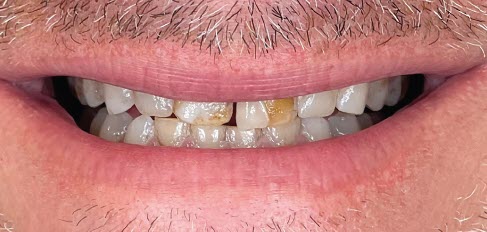
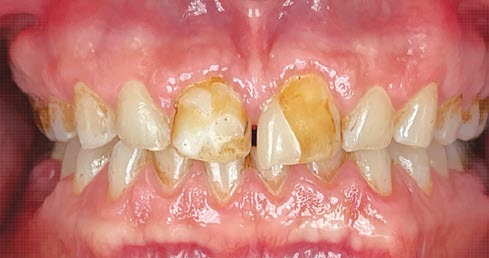
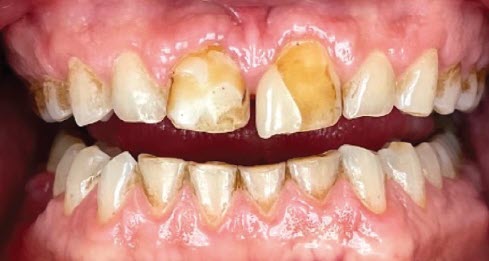
In their CE courses, the Dr. Dick Barnes Group teaches that every patient should receive the best treatment plan, regardless of their perceived ability to pay. They also teach that dentists never know when a patient’s financial circumstances may change, and as it happens, my patient had recently received money from an inheritance. Without hesitation, the patient told me that the first thing he wanted to do with his windfall was to get a permanent solution for his dental issues. We were able to move forward immediately with treatment.
STARTING TREATMENT
A full mouth case with implants is not a simple appointment. I explained to the patient that it would be a several-months-long process to get things done right. The patient’s concerns were primarily aesthetic, but we needed to address the functional aspects of his dentition as well.
The patient still had his wisdom teeth, but they were not a hindrance. We agreed to do work on his uppers and lowers, second molar to second molar. The patient accepted the entire treatment plan.
I worked with Arrowhead Dental Laboratory throughout the process and sent them the patient’s scans for a white wax-up. While Arrowhead worked on that, I tackled tooth number 30, which already had a root canal that was failing. I extracted the tooth and eventually placed an implant. The extraction was challenging because the patient had dense bone, but everything turned out great. After the implant healed, I showed the patient the wax-up and we were able to approve the direction for his new smile.
Next, I turned my attention to his severely collapsed bite. The patient’s bite had a Shimbashi measurement of about 12 mm, so I knew we had to open his bite fairly significantly—about 4 mm. Arrowhead made a removable orthotic to stabilize the patient’s bite and make sure the measurement of the opening was comfortable. I told the patient to wear the orthotic all the time for about six weeks. He also needed to adhere to a soft diet while wearing the orthotic. This process would test his muscles and make sure that we would restore him to the right opening, which ended up being a Shimbashi measurement of 16 mm.
The patient was compliant with wearing the orthotic and following the soft diet protocol. Soon afterwards, he explained that he was no longer waking up with headaches. He was comfortable with the position of the bite and even ate with the orthotic in. It took a couple of months to test everything before we could move on and work on the upper arch.
When it came time for treatment, I started by prepping the upper arch and placing the temporaries. I followed the sequence that I learned in the Full Arch Reconstruction class from Dr. Jim Downs. I printed out the sequence of what I learned from the class and placed it on the counter so it was visible to me throughout the procedure.
Treatment went smoothly. All the tools that Arrowhead provided, from the white wax-up to the temporary matrix and the reduction guide, helped the process go seamlessly.
After placing the temps, the patient was so happy with the upper arch, he was anxious to move on with more treatment. I asked him to wear a new orthotic on the lowers because I wanted to test his bite with the temps.
He came back to the office 72 hours after we placed the upper temps so that we could check the bite and make minor adjustments. A month later, we received the permanent restorations for the upper arch and seated them. Everything went well.
WORKING ON THE LOWERS
The week after seating the permanent restorations on the uppers, the patient returned to start work on the lower arch. At the time, I suggested doing a bridge with Snowcaps (temporaries made from Radica®) on the lowers, which would hold him for several months if needed. [Arrowhead now uses PMMA for a similar product]. But the patient didn’t want to wait, so I temporized the lowers. We tested the temps on his lowers for about a month.
About a week after cementing the temps, the patient experienced pain on tooth numbers 31 and 32, so I referred him to an endodontist. He needed endo treatment on tooth 31 and an extraction of tooth 32. The endodontist was able to do the root canals through the temps. Afterwards, I did the extraction on tooth number 32. After the tooth healed, I was able to cement the permanent restorations on the lowers.
The lowers were a bit more time-consuming than the uppers because a patient’s tongue is always a factor. But everything fit perfectly, just like pieces of a puzzle. The patient is now completely restored. We used Arrowhead’s e.max® Prime for the posterior restorations and traditional IPS e.max® for the anterior restorations.
I had a nocturnal orthotic made for the patient to wear to protect his permanent restorations. I also suggested he work with a physician to address some of the health issues that may have contributed to the breakdown of his original dentition.
RESULTS


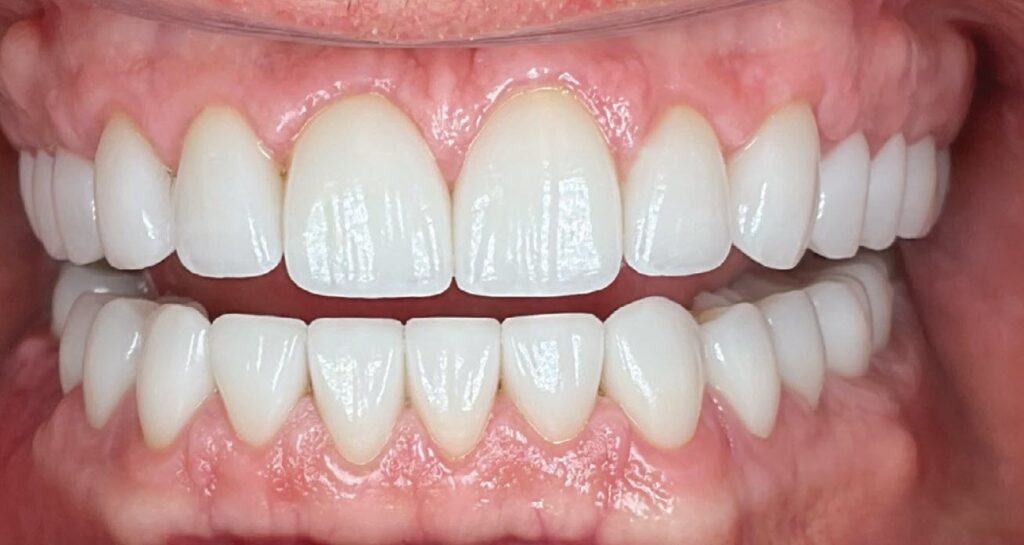
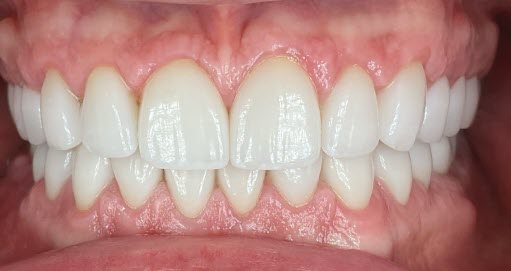
As mentioned, the patient has worked at the same job for several years. After he returned to work with his new smile, he said, “People think I look so much younger and healthier.” He also said, “This was the wisest investment I have ever made for myself. Everyone has said that I am so lively now and back to my old self. I feel comfortable talking to people without being embarrassed and hiding my teeth. I haven’t felt like this in a really long time.” He was very emotional when voicing his appreciation. Overall, he is much happier, and it shows.
RECOMMENDATIONS
For any doctor considering a complex case, I recommend setting yourself up for success by double-checking that you have everything you need ahead of time. The week before I started working on the case, I made sure everything was fully in place for the large treatment. By taking time to ensure that everyone on the team knew their part and what needed to happen for the optimal outcome, we avoided any problems, and the process was easier for us and for the patient. On the day of treatment, I didn’t have to scramble to find anything; everything was set up exactly the way I wanted. In addition, everything Arrowhead provided made my job much less stressful and helped so much. I couldn’t be happier with the results and for my patient’s new smile









